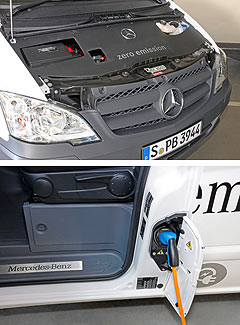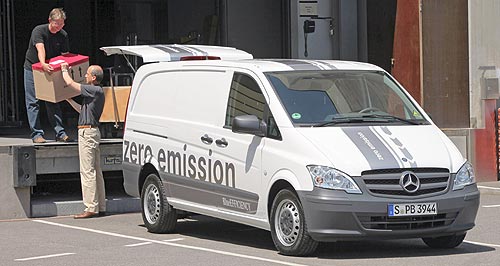Make / Model Search
Future models - Mercedes-Benz - Vito - E-CellElectric Vito van hits EuropeOn trial: Mercedes-Benz's Vito E-Cell is already running around German cities. Australia puts its hand up for Mercedes’ Vito E-Cell as trials start in Europe29 Jul 2010 By TERRY MARTIN MERCEDES-BENZ has issued fresh details on its fully electric Vito van and confirmed that the vehicle is now in small-scale production ahead of a bigger rollout of 2000 vehicles next year. Now known as the Vito E-Cell, the electric van was shown as a prototype in February at an EU Competitiveness Council meeting in San Sebastian, Spain. There is currently no timetable for its release in Australia, but the first examples from an initial run of 100 vehicles have hit the streets in Berlin and Stuttgart as part of a four-year real-world trial with customers, and in the coming months will roll out into the Basque region of Spain, where the Vito is built in conventional and now zero-emissions form. A spokesperson for Mercedes-Benz Australia/Pacific told GoAuto: “Currently there is no timeframe for an Australian trial of the electric Vito van, but we have requested its use when units become available.” Joining the fledgling Sprinter EV program, which has around 50 vans placed with fleet operators and public bodies in Stuttgart, the Vito E-Cell is being produced in both left- and right-hand drive configurations.  It offers an operating range of 130km from its permanent synchronous electric motor and 400-volt, 16-amp lithium ion battery combination, which Mercedes believes is compatible with its city-oriented customers’ 50-80km average daily mileage. Ditto for the 80km/h top speed. It offers an operating range of 130km from its permanent synchronous electric motor and 400-volt, 16-amp lithium ion battery combination, which Mercedes believes is compatible with its city-oriented customers’ 50-80km average daily mileage. Ditto for the 80km/h top speed.The motor has a peak power output of 70kW – down from the 90kW originally quoted – but develops a continuous output of 60kW, and has a maximum torque of 280Nm. There are no cargo volume or payload penalties, the latter remaining around 900kg, although the desire to save space with battery installation has seen the E-Cell – which is based on the long-wheelbase standard-roof model – become the only Vito with front-wheel drive. The E-Cell carries a few suspension components adopted from the 4x4 Vito, but otherwise the front-drive system was specifically developed for the EV. The single-speed transmission which drives the front wheels is also unique to this model. The batteries are housed under the load compartment floor and have a total capacity of 36kWh, with around 90 per cent of this (32kWh) available to power the vehicle – a percentage Mercedes claims is “outstandingly high” compared to other EVs. The battery pack comprises 16 modules with a total of 192 cells, all monitored by a “battery management system” that automatically deactivates the high-voltage network when the vehicle is parked to avoid unnecessary power losses and to prevent unauthorised people tampering with it. Battery recharging takes around 12 hours from a conventional 230-volt mains power outlet, depending on the charge status, although Mercedes has set up rapid-charge stations in Berlin and Stuttgart which up the ante to 380 to 400 volts and reduce the charging time to six hours. The onboard chargers have an output of 6.1kW, while the charging technology is advanced enough to interact with the power grid to manage charge times and so on. The batteries are also charged using brake energy recuperation when on the move. According to Mercedes, the Vito’s body is completely unmodified and is only distinguished from the regular model via decor. The charging socket is located behind the fuel filler cap, while the ground clearance and approach/departure angles are “practically unchanged” which is important when driving up ramps and other applications specific to commercial vehicles. The engine bay houses the electric motor and other components such as power electronics, transformer and mains charging unit. The 12-volt onboard network is also newly developed for the EV, while the electrical components of the drive system are all water-cooled. A reversing camera and audible warning device are fitted standard to the E-Cell to compensate for the lack of noise from the EV. Mercedes also claims the E-Cell is as safe and reliable as regular Vito models, with testing conducted over a range of extreme conditions. Standard safety features include dual front airbags and electronic stability control. With the E-Cell rolling down the same line as other Vito models at its plant in Vitoria, Spain, Mercedes-Benz says “this further demonstrates that the Vito E-Cell is by no means an experimental vehicle or a prototype, but rather a van on its way to series production”. The company has also developed specialist workshops in Germany and an emergency call centre, all with a view to series production. The current customer trials are scheduled to run for four years or around 80,000km per vehicle, each of which is being leased in a similar way that Mitsubishi is handling the initial rollout of its i-MiEV EV hatch in Australia.  Read more6th of July 2010  Mercedes Vito van cleans upBenz tweaks workhorse Vito with new look, Euro 5 emissions and fuel-efficiency gainsAll future models Alfa Romeo Alfa Romeo Abarth Abarth Alpine Alpine Alpina Alpina Audi Audi Aston Martin Aston Martin BMW BMW Bentley Bentley Chery Chery Brabham Brabham Chrysler Chrysler Chevrolet Chevrolet Cupra Cupra Citroen Citroen DS DS Dodge Dodge Fiat Fiat Ferrari Ferrari Foton Foton Ford Ford Great Wall Great Wall FPV FPV Haval Haval GWM GWM Honda Honda Holden Holden Hummer Hummer HSV HSV Infiniti Infiniti Hyundai Hyundai Jaguar Jaguar Isuzu Isuzu Kia Kia Jeep Jeep Land Rover Land Rover Lamborghini Lamborghini Lexus Lexus LDV LDV Mahindra Mahindra Lotus Lotus Mazda Mazda Maserati Maserati Mercedes-AMG Mercedes-AMG McLaren McLaren MG MG Mercedes-Benz Mercedes-Benz Mitsubishi Mitsubishi Mini Mini Opel Opel Nissan Nissan Peugeot Peugeot Pagani Pagani Proton Proton Porsche Porsche Renault Renault Ram Ram Rover Rover Rolls-Royce Rolls-Royce Skoda Skoda Saab Saab SsangYong SsangYong Smart Smart Suzuki Suzuki Subaru Subaru Toyota Toyota Tesla Tesla Volvo VolvoVito pricing
Motor industry news |
Click to shareMercedes-Benz modelsResearch Mercedes-Benz All future models Alfa Romeo Alfa Romeo Abarth Abarth Alpine Alpine Alpina Alpina Audi Audi Aston Martin Aston Martin BMW BMW Bentley Bentley Chery Chery Brabham Brabham Chrysler Chrysler Chevrolet Chevrolet Cupra Cupra Citroen Citroen DS DS Dodge Dodge Fiat Fiat Ferrari Ferrari Foton Foton Ford Ford Great Wall Great Wall FPV FPV Haval Haval GWM GWM Honda Honda Holden Holden Hummer Hummer HSV HSV Infiniti Infiniti Hyundai Hyundai Jaguar Jaguar Isuzu Isuzu Kia Kia Jeep Jeep Land Rover Land Rover Lamborghini Lamborghini Lexus Lexus LDV LDV Mahindra Mahindra Lotus Lotus Mazda Mazda Maserati Maserati Mercedes-AMG Mercedes-AMG McLaren McLaren MG MG Mercedes-Benz Mercedes-Benz Mitsubishi Mitsubishi Mini Mini Opel Opel Nissan Nissan Peugeot Peugeot Pagani Pagani Proton Proton Porsche Porsche Renault Renault Ram Ram Rover Rover Rolls-Royce Rolls-Royce Skoda Skoda Saab Saab SsangYong SsangYong Smart Smart Suzuki Suzuki Subaru Subaru Toyota Toyota Tesla Tesla Volvo VolvoVito pricing
Motor industry news |











Facebook Twitter Instagram